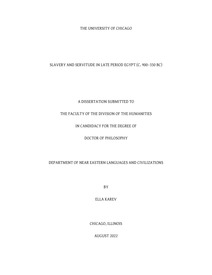This dissertation defines the nature and extent of slavery in Egypt of the Late Period, from the end of the Third Intermediate Period (c. 900 BC) to the beginning of the Ptolemaic Period (c. 330 BC). The scant documentation from this period means that it has often been understudied or ignored; even when the Late Period was covered in studies of compulsory labor in Egypt, scholarship often assumed that chattel slavery was simply non-existent before the arrival of Alexander the Great. This dissertation demonstrates that although slavery of this period was certainly different from the Ptolemaic Period—which evidenced large-scale, commercialized, and taxed slavery—the Late Period did indeed evidence chattel slavery, including the hereditary nature of slavery, re-sale, leasing, and even branding of enslaved persons. The chief takeaways from this study are split into four: first, that a practice which can be described as slavery in modern legal taxonomy did exist in Late Period Egypt, challenging some previous scholarship; second, that this practice took the form of small-scale, personal transactions that often overlapped with familial obligations and other systems of patronage and protection; third, that the value of enslaved persons lay in their dual purpose as laborers and economic tools; and finally, that the majority of enslaved persons in Egypt originated from Egypt, in contrast with earlier and later periods. The structure of this dissertation follows four methodological approaches, each represented by a thematic chapter: Chapter 2 follows a philological approach, tracking usage of terms; Chapter 3 follows a legal approach, examining the clauses used in legal documentation of enslavement; Chapter 4 follows an economic approach, assessing the value of labor and wages; and finally, Chapter 5 follows a sociological approach, using onomastics, prosopography, and modern theories of enslavement to investigate the lived experience of enslaved persons in Late Period Egypt. Chapter 6 summarizes the findings of this study, and the dissertation is followed by an appendix of thirty-four texts related to enslavement with updated transliterations, translations, and commentary.
Record Created 2022-09-0










 Stumble It!
Stumble It!

No comments:
Post a Comment